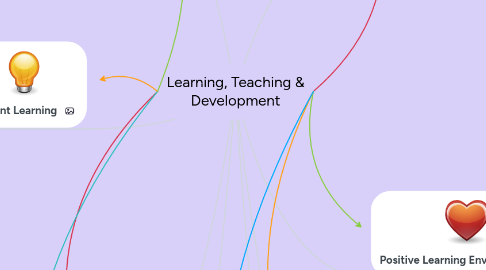
1. Student Assessment
1.1. Modification for students with IEPs
1.1.1. Learning Disability, Developmental Disorder
1.2. Planning
1.2.1. Student Learning Profiles
1.2.1.1. Diagnostic
1.2.2. Student Interests
1.2.2.1. Recognizable from previous patterns and choices, i.e. books of interest
1.2.3. Student Readiness
1.2.3.1. Situational behaviour
1.2.4. Curricular Planning
1.2.4.1. Various assessment plans for different areas of the curricula
1.3. Oral
1.3.1. Talks, Speeches, Oral Presentations
1.4. Written
1.4.1. Tests
1.4.2. Projects
1.5. Individual
1.6. Group
2. Student Learning
2.1. Tasks
2.1.1. Complex but attainable
2.2. Control
2.2.1. Students make decisions, plan and set individual goals
2.3. Self-Evaluation
2.3.1. Students monitor their learning and outcomes and modify goals
2.4. Collaboration
2.4.1. Teacher-student collaboration for problem solving
2.5. Development
2.5.1. Reflective Practices
2.5.1.1. Analyze and reflect
2.5.1.2. Growth Mindset
2.5.2. Vygotsky
2.5.2.1. Scaffolding
2.5.2.1.1. Assess learner's knowledge
2.5.2.1.2. Break down task
2.5.2.1.3. Build on prior knowledge
2.5.2.1.4. Use verbal cues
2.5.2.2. Zone of Proximal Development
2.6. Inquiry Based Learning
2.6.1. Collaborative
2.6.2. Observation
3. Multiple Intelligences
3.1. Visual
3.1.1. Pictures, books, videos, demonstration
3.2. Auditory
3.2.1. Verbal instruction, auditory (recorded) instruction
3.3. Tactile
3.3.1. Acting out learning, experiments, drama
3.4. Piaget Theory
3.4.1. Adaptation
3.4.1.1. Adjusting to environment
3.4.2. Schemes
3.4.2.1. Organizing thoughts and behaviours
3.5. Self Determination
4. Educational Psychology
4.1. Learning & Cognition
4.1.1. Cognitive Perspective
4.1.1.1. Mental Processes are important to learning
4.1.1.2. Construct meaning from stimuli
4.1.1.3. Bring knowledge to each new learning situation
4.2. Development
4.2.1. Progressive cognitive development
4.3. Social & Cultural Influences
4.3.1. Educational habits and priorities at taught at home
4.4. Motivation
4.4.1. Shown at home and in school
4.5. Behaviour/Classroom Management
4.5.1. Classroom Chores/Duties
4.6. Individual Differences
4.6.1. Different learning styles
4.7. Assessment & Evaluation
4.7.1. Allows for variation, not standardized
4.8. Teaching & Instruction
4.8.1. Interactive, not just teacher-student lecture based
4.9. Psychological Foundations of Curricula
5. Instructional Approaches
5.1. Teacher Centred Approach
5.1.1. Teacher determines content, provides direction, and sets academic and social tone
5.2. Student Centred Approach
5.2.1. Teacher adopts constructivist perspective and acknowledges that students actively construct their own understandings
5.3. Universal Design for Learning
5.3.1. Accessible learning for all students
5.4. Differentiated Instruction
5.4.1. Various ways to teach the same lesson
5.4.2. E.g. videos, activities/experiments, group work
5.5. Response to Intervention
5.5.1. Balanced day
5.6. Top-Down Approach
5.6.1. Determine curricula for the year
5.6.2. Determine curricula for the term
5.6.3. Organize curricula into units
5.6.4. Determine daily lessons
5.7. Pause Day
5.7.1. Catch up on previous work, teach nothing new
6. Positive Learning Envionments
6.1. Requires planning and management
6.2. Opportunities for all
6.3. Accessible tools and materials
6.3.1. Student's with exceptionalities have available resources
6.4. Welcoming environment
6.4.1. Safe Space
6.5. Effective Lighting
6.6. Respecting people and property
7. Common Places of Education
7.1. Teacher
7.1.1. Facilitator
7.1.1.1. Guides knowledge and behaviour
7.2. Topic
7.2.1. Curricula
7.2.1.1. Unit
7.2.1.1.1. Specific lesson
7.3. Setting
7.3.1. Learning environment
7.3.1.1. School
7.3.1.1.1. Classroom
7.4. Student
7.4.1. Responsible for their own knowledge
7.4.1.1. Growth mindset
8. Principles of Development
8.1. Orderly progression/gradual process
8.2. Periods of rapid and slow growth
8.2.1. Biological and environmental
8.3. Quantitative and qualitative changes
8.4. Individuals develop at different rates
8.5. Genetics set developmental portent
8.5.1. Determine strengths and weaknesses
8.5.1.1. Gender differences
8.6. Environment determines potential realized
8.6.1. Parental encouragement
8.6.1.1. Out of school opportunities
